People
‘Art Doesn’t Need Glamour, Glamour Needs Art’: Designer Duro Olowu on What Fashion Brands Must Do to Collaborate Successfully With the Art World
Olowu's sprawling show at the Museum of Contemporary Art in Chicago is now online.
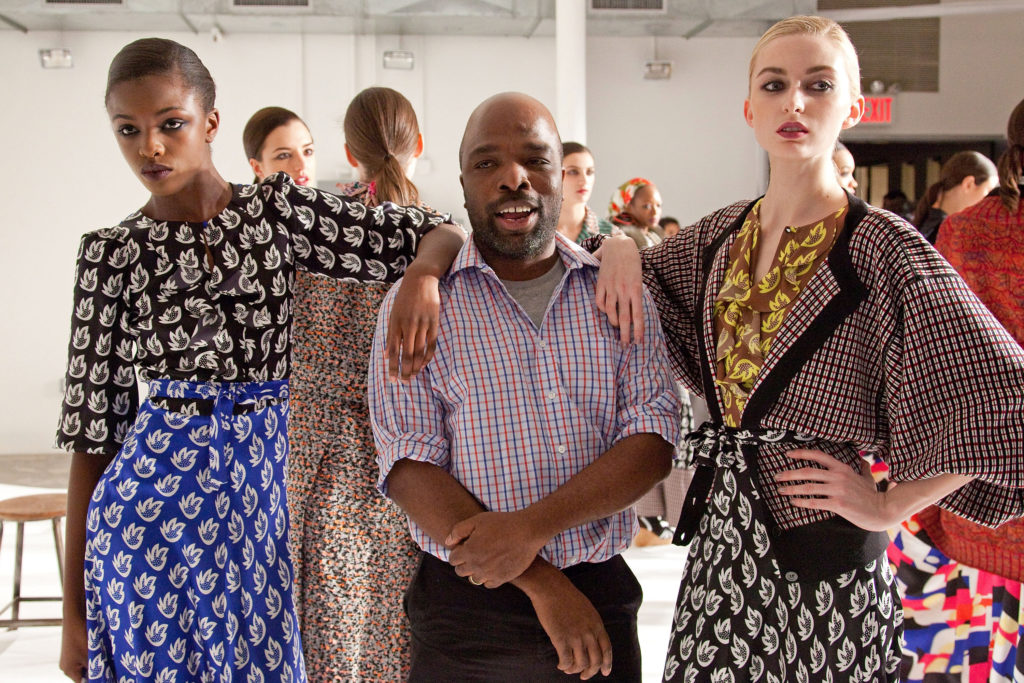
Olowu's sprawling show at the Museum of Contemporary Art in Chicago is now online.

Noor Brara

Over the course of his career, Nigerian-born British designer Duro Olowu has made fans of women like Michelle Obama, Solange Knowles, and Iris Arpfel, all of whom have flocked to his brightly patterned, eclectic dresses that draw on his experiences as a child raised in Lagos, London, and Geneva.
Yet unbeknownst to many, in recent years, Olowu—who splits his time between London and New York, where he shares a home with wife Thelma Golden—has begun parlaying his love for color and pattern into a second career in the art world, curating shows for Salon 94 gallery and the Camden Art Center in England.
But it’s his third and most recent show, “Duro Olowu: Seeing Chicago”—a 400-piece exhibition at Chicago’s Museum of Contemporary Art—that he’s most proud of. A love letter to the city and its women who have long supported his designs, the show brings together objects belonging to Chicago’s public institutions and private collections.
Recently, after a hugely successful opening in February, the exhibition was put online and extended through September. From his home in London, Olowu called Artnet News to talk about how the show and its online edition came to be, how the fashion business needs to change in the age of COVID-19, and how growing up around the world has informed his creative ethos.
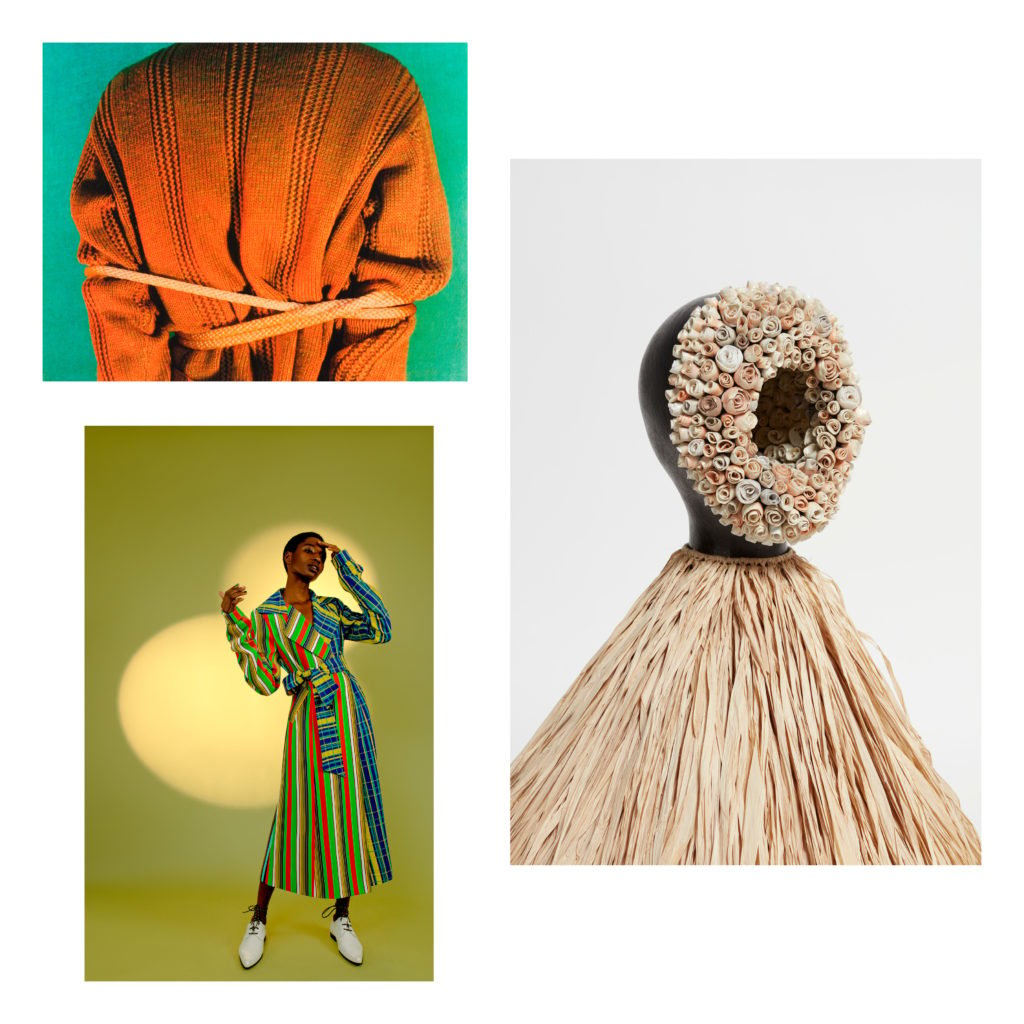
Clockwise from top: Bruce Nauman, Bound to Fail (from the portfolio Eleven Color Photographs) (1966-67/1970/2007). Collection Museum of Contemporary Art Chicago, © 2019 Bruce Nauman/Artists Rights Society (ARS), New York, Photo: Nathan Keay, © MCA Chicago. Simone Leigh, No Face (House) (2017). Photo: © Simone Leigh; Courtesy of the artist and Luhring Augustine, New York. Duro Olowu, Spring/Summer 2020, Look 7. Photo: Christina Ebenezer.
As a designer, how has life changed for you? Obviously, you don’t have the same access to your team or to your atelier. How have you had to adapt?
I actually closed my atelier on March 10, just before the MCA show in Chicago, which, thank god, was open for two weeks. I have a very small team. I have people that make my samples, but I design everything myself. And so the only question was financial. The way I run my company, I have total control, so there were certainly decisions for everyone’s benefit that I could make. I didn’t have to think, “Oh, do I keep paying this person?” I just said, “Well, I’m going to keep paying them until I can’t.”
So these decisions are really easy to make, in a way, although of course they’re more difficult to execute financially. But people have been through worse. I know there’ll be huge challenges ahead for this business. Like for magazines—you can’t shoot or have more than a few people in a room. I don’t make things in big factories. I have a small atelier, but you still have to think of how things are going to be made.
As far as shows go, five years ago, I stopped doing runway. But I was lucky, because I was in a position where I had the space to say, “It’s just not fulfilling to do this, it’s all over in 15 minutes.” It’s just a waste, you know? I decided to make the presentation process more creative, so I did these salon-type things and it was great because all the editors would come in small groups, and they would see all the clothes up close on the models. I would shoot and style the collection beforehand, so that they could take home the pictures right after. And that worked really well.
But now, even in a small setting, you can’t bring in groups of more than two people, so even that has to be rethought.
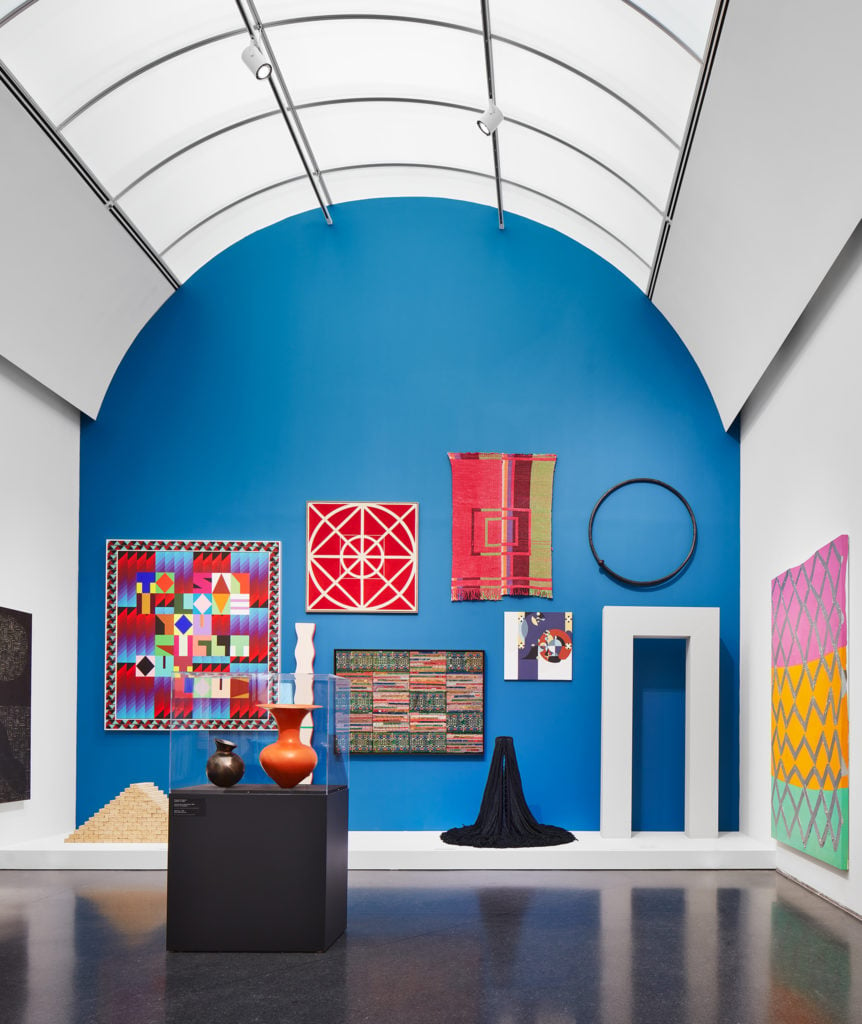
Installation view, Duro Olowu: Seeing Chicago, 2020. Photo: Kendall McCaugherty.
Your exhibition, “Seeing Chicago,” at the MCA has been extended through September. In the meantime, the museum has launched a virtual version of the show with video footage, supplementary imagery, and audio interviews. Tell me about how the digital show came to be and how involved you were. How do you feel it compares to the real thing?
First of all, I feel really grateful that it opened and that the public really started going to see it. I’m thrilled that the MCA has decided to make a virtual version and extend it, especially because some people can only afford to go see it on a free day. So, this way, people can either see it when it opens back up again or at least have a visit while they’re at home.
It has about 400 pieces in it—for me, they’re amazingly joyful, incredible works of art. It was an amazing opportunity to be around all that art and to work with the MCA team, from the hangers to the book editors. The funny thing is, I only do Instagram, and until eight years ago, I had a flip phone. I’m not the most technically savvy person. So of course, whenever I see anything virtual, I go, “Oooh!”
Honestly, I only saw the final version a week before it went up, and normally I have final approval of every detail, down to the lettering on the door. But I approved it immediately, and I changed only one thing. I’m very conscious about my face and my voice on the web, but really, if I just went online and saw this, I’d be impressed. The city of Chicago is represented beautifully in the virtual version. The MCA team deserves an Academy Award for virtual interpretation of this show, truly.
Tell me about how the exhibition happened in the first place. You aggregated all these great works from the private and public collections of Chicago largely to show the breadth of the city’s art and culture to its own community. Why were you interested in doing that?
Chicago is such an incredible city, and people can’t imagine the kind of art there is there, in both the private collections and the institutions. Initially, [museum director] Madeleine Grynstztejn wanted me to do an exhibition of my fashion work, and I said, “No, that’s not the show I’m interested in doing.” So then she said, “Okay, whatever you want to do is fine.”
It’s funny because as we were working on it, the team said, “Okay, this looks good. Might we have a mannequin here, maybe?” And I said, “No, no mannequins! No fashion!” [laughs] I’m not saying fashion and art are not the same or similar in any way, but I wanted to recontextualize that relationship. So you’ll see that any mannequins we have in the show are actually there to represent the women of Chicago who have always bought my things for all these years and have been so supportive. They are viewers of the show, you know? The fashion or style elements are there to represent the personalities of these people who are responsible for all of this art being in the museums. And the thing about it is, honestly, fashion doesn’t interest me at all. It never has. I like style. I like the culture of style and I love art as a cultural endeavor. I think that style is an art, but in the sense that style is informed by art.
What is really interesting for me is just to show people what they’ve got. It’s almost like opening your wardrobe that you’ve had for 20 years and thinking, “I’m always trying to go for the next thing, but have I really looked at what I have in here?” And the thing about Chicago is that the Matisse at the Art Institute, or the Cindy Sherman at the MCA, or the Stanley Whitney or Dawoud Bey or Lynette Yiadom-Boakye or Lorna Simpson or Alma Thomas they have are very different from what is elsewhere in the world, and they were obtained really early.
A lot of things in the show are works you’ve never seen by those people. That is the distinct nature of the sort of Midwestern ethos. It’s a “We don’t follow trends, we go from the gut” Chicago thing that I love.
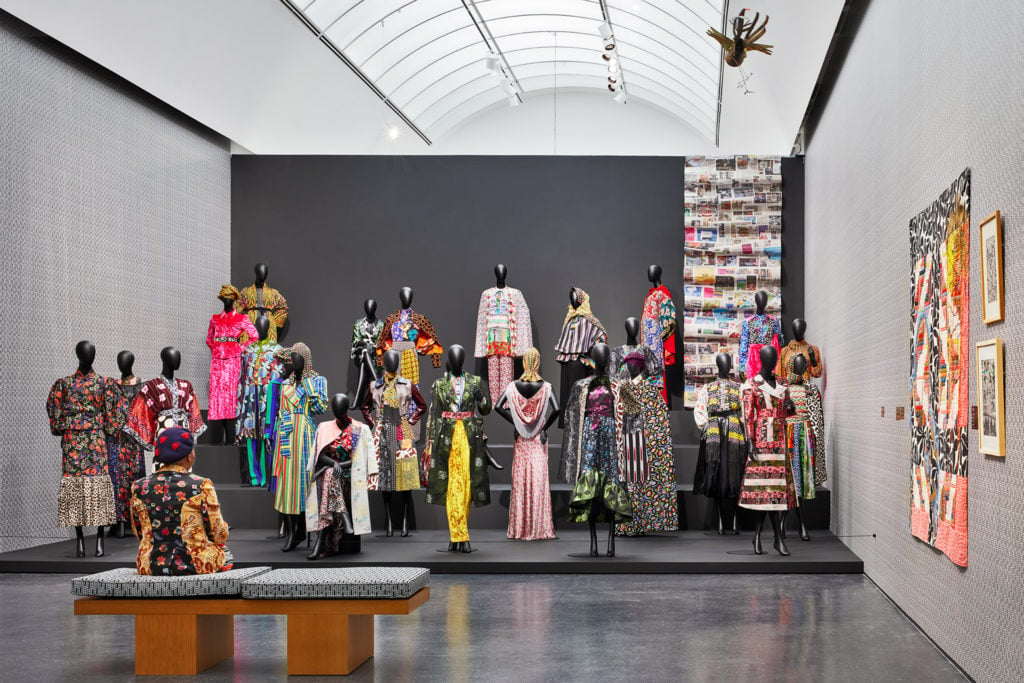
Installation view, Duro Olowu: Seeing Chicago, 2020. Photo: Kendall McCaugherty.
I know you grew up spending your formative years amongst multiple cultures and different cities, which has informed a lot of your work. What did you notice about the texture of Chicago’s culture? And how do you feel your internationalism has shaped your eye, as a curator and a creative person?
I think we are definitely where we come from, and where we’re going also determines that. I don’t believe in nationality, as a banner of identity—it’s why I don’t really like flags. I never have. I consider myself a Nigerian-born British designer, but I’m Nigerian, you know? And Jamaican, because my mother’s Jamaican. I use those sub-definitions only because, in relation to what I do, people will say, “Oh, my god African prints!” And I’m like, “They’re not African prints.” Maybe it’s the color combination, but none of them are. So you have to teach people a lot.
I think that where you’re from is important as a kind of explainer for your particular aesthetic. And living in a place is certainly different than just visiting. It’s not enough just to say, “Oh, I’m going to Cairo to have a tea at the Ramses Hilton,” and think you’ve had the Cairo experience. No! And I have very eloquent, sophisticated people who come up to me and say, “Oh, you’re from Africa. I’ve been to Africa.” I always say, “I’m from Nigeria,” and, “Can you tell me where in Africa you’ve been?”
I stop myself from saying things that are too general because those categorizations are restrictive. And I think that comes through in this show—it’s an incredibly international show. When you have this multicultural background, it really teaches you to keep your eyes open and sort of inhale everything. It’s like switching languages or switching attitudes—they co-exist within you.
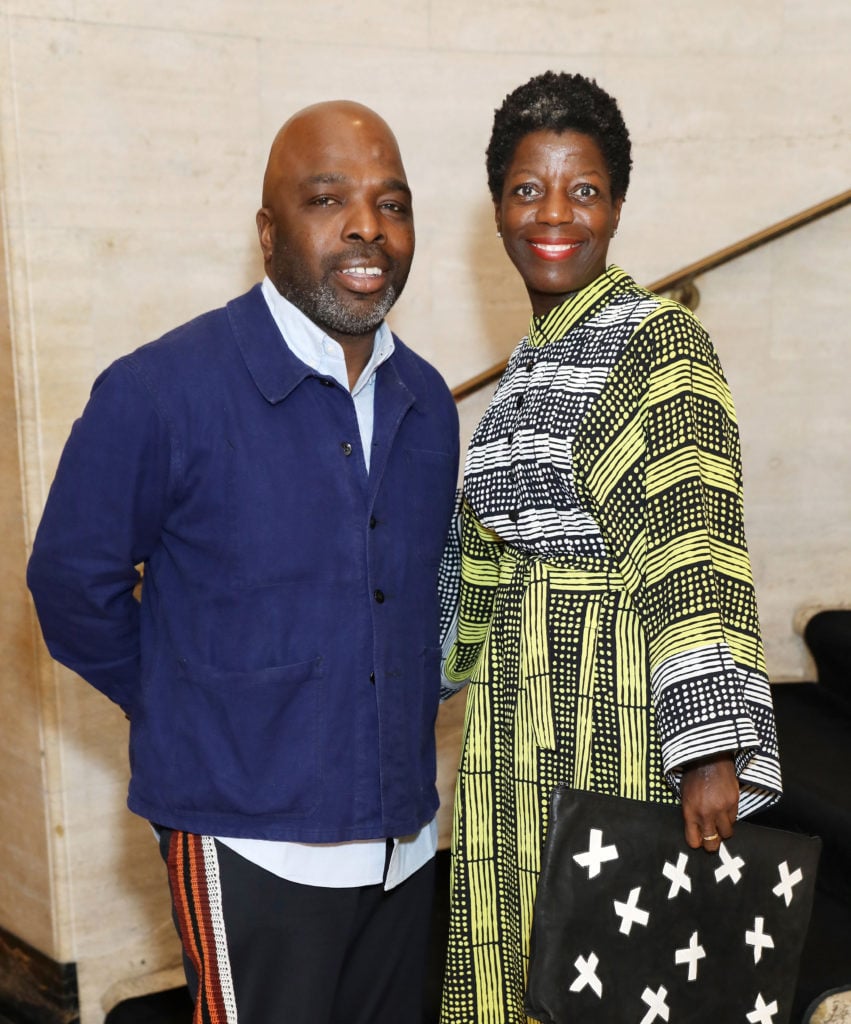
Duro Olowu and Thelma Golden. Photo by Darren Gerrish/WireImage
You are, of course, married to a powerhouse curator. Did Thelma Golden help you in any way to realize this show?
It’s very interesting you ask me that because Thelma never knows what’s going on with my shows. [laughs] She loves my clothes so much—she always asks what they’re about, what I’m working on. And I tell her, “You have to wait like everyone else and go tomorrow morning to see the collection on Vogue.com.” But I’m lucky that she wants to enjoy the work in the same way as other people.
Thelma and I respect each other in part because of what we do. I have enormous respect for her talent and her enthusiasm, and not because she champions artists of color, but because she champions art and artists. And her specific mandate is artists of color, because that is something that needs doing, and I love that. I get excited by it, and I discover artists through her.
One thing I will share that continues to guide me is this piece of advice she gave me early in our relationship. I was always editing my collections really early, and we would talk about them, and I would say, “Next time, I think I’ll cut this and this,” and she said, “No, you have to make everything. And then edit.” And I know that that’s how she talks to artists, too. It’s not about being extravagant, but don’t over-edit in your head while you’re doing something. It’s like eating the ingredients before the meal gets made.
Art world people are often wary of fashion people who talk about art. The notion that fashion is a form of art is also prone to getting a lot of eye rolls. But your exhibition has been received so positively by the art world. Why do you think that is?
Of course being involved with the art world and being with Thelma and meeting people through her has helped. I also think that I didn’t go into doing this with arrogance, and I was never too cocky about the whole thing. I think when the viewer goes to see a show—and I’m talking about the public, the mass public—it’s successful when it really speaks to them in a simple, fundamental way. I think this show does that.
Also, it’s is not about shopping. I think the art world is really sensitive to this—that commerce, which we all need to some extent, takes over. But not for the public. I really think that they need to see something that was not just worth it for the money, but brought something into their lives or the lives of their children.
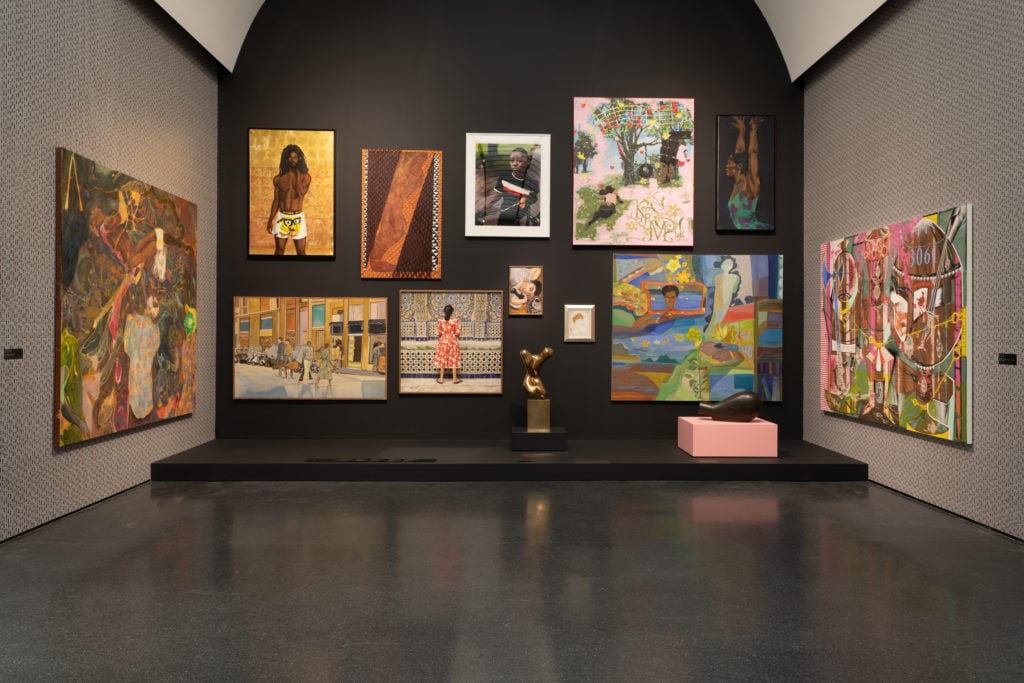
Installation view, Duro Olowu: Seeing Chicago, MCA Chicago 2020, Photo: Nathan Keay, © MCA Chicago
The worlds of fashion and art are coming closer together in more ways than before. What do you make of the art-fashion collaboration trend? What’s in it for designers?
I think artists and designers have always done it, that’s nothing new. Willi Smith, for example collaborated with Christo, Jenny Holzer, you name it. The thing is, it has to be done in a certain way for it to be legitimate. Most of it is done in a “take the work and slap it on a piece of something” way, which, you know, means nothing. Some of the big collaborations are visually very beautiful, but what dismays me is that they’re not made for keeps or to endure. They’re made as disposable items and then the brand says, “Next!”
My thing is, if you’re a big fashion company with a gazillion dollars, go to smaller museums all over America and do projects there. Because if you have enough to put into major artists or big art events, you have enough to give to the people who really need it. It’s just that a lot of them aren’t that generous.
So I think it’s about the integrity of the finished project, and who you choose to support—you know, it can be like taking from Peter to pay Paul. If you’re going to sponsor art, then sponsor art in a way that it gives to the public. But I think it’s over now anyway, all that fashion-party-for-art stuff. The thing is, art doesn’t need glamour. Glamour needs art.